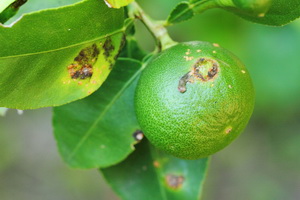
Researchers Find New Clues on How to Stop Spread of Citrus Greening
March 28, 2018| |
 Researchers from Boyce Thompson Institute (BTI) and the USDA Agricultural Research Service (USDA-ARS) found new clues about how the bacteria linked to citrus greening infect the only insect that carries them which could lead to finding the solution on how to block the spread of infection. The results are published in Infection and Immunity.
Researchers from Boyce Thompson Institute (BTI) and the USDA Agricultural Research Service (USDA-ARS) found new clues about how the bacteria linked to citrus greening infect the only insect that carries them which could lead to finding the solution on how to block the spread of infection. The results are published in Infection and Immunity.
Citrus greening (a.k.a. huanglongbing) is a major problem in citrus production worldwide. Infected trees are unable to get enough nutrients from the soil, their leaves turn yellow, young twigs die back, and fruit remains small and green, which is not suitable for sale. Eventually, the trees die completely. These symptoms are linked to a bacterium (Candidatus Liberibacter asiaticus or CLas) which is spread by an insect vector called Asian citrus psyllid. Several strategies have been employed by citrus growers to control the disease but none has been proven to be effective in the long-term.
BTI professor and USDA-ARS researcher Michelle Heck and team aimed at developing a long-term solution by focusing on an important point: not all psyllids are equal in their ability to spread the disease. Previous studies have shown that nymphs are better than adults in terms of acquiring the bacteria from trees. Heck also previously found out that the adults's gut cells go through a severe stress response during CLas infection, leading to disruption of cell nuclei. In the recent study, they found out that nymphs rarely reached the same level of nuclei disruption observed in adults.
The next step of Heck's team is to identify the mechanism for resistance in the nymphs so that it might be reversed to stop the spread of CLas.
Read the media release from BTI.
| |
Biotech Updates is a weekly newsletter of ISAAA, a not-for-profit organization. It is distributed for free to over 22,000 subscribers worldwide to inform them about the key developments in biosciences, especially in biotechnology. Your support will help us in our mission to feed the world with knowledge. You can help by donating as little as $10.
-
See more articles:
-
News from Around the World
- Drought Causing Highest Losses in Agri among All Disasters, Report
- Unique Communication Strategy in Pathway that Controls Plant Growth Discovered
- New Insights on How Cellulose is Built Could Indicate How to Break it Apart for Biofuels
- Researchers Find New Clues on How to Stop Spread of Citrus Greening
- Scientists Discover Circadian Clock Controls Cell Cycle in Plants
- International Team Finds a Way to Stop Rice Blast Spread
-
Research Highlights
- SlMAPK1 Overexpression Enhances Drought Tolerance in Tomato
- Gene Responsible for Cadmium Accumulation in Rice Grains Found
-
Beyond Crop Biotech
- Hoppy Beer Without the Hops
- New CRISPR Tool Restores Protein Imbalance in Dementia Patient's Cells
-
Announcements
- Training Workshop on ComRes for Scientists
-
Resources
- CAST Issue Paper Discusses Regulatory Barriers to AgBiotech
- Open Access Wild Tomato Genome Now Available
- ISAAA SEAsiaCenter in 2017
-
Plant
- Brassinosteroids Regulate Secondary Cell Wall Formation in Poplar
- Scientists Prove CRISPR's Potential As Control for Queensland Fruit Fly
- CRISPR-Cas9 Can Modify Cotton Bollworm Genes
- Researchers Discover Gene for Salt Stress Sensitivity in Rice
-
Read the latest: - Biotech Updates (December 17, 2025)
- Gene Editing Supplement (December 17, 2025)
- Gene Drive Supplement (February 22, 2023)
-
Subscribe to BU: - Share
- Tweet
